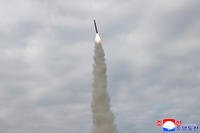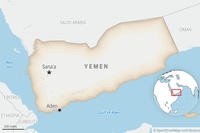SELAH CIVIC CENTER, Yakima County — Years after a group of substances often described as forever chemicals were found in drinking water near Joint Base Lewis-McChord’s Yakima Training Center, families are still waiting for water filtration systems, and state officials are frustrated with the Army’s “pattern of slow or no release of information” about the contamination.
Washington state officials have ramped up pressure on the Army since Gov. Bob Ferguson was sworn in and appointed Casey Sixkiller, a former regional administrator for the U.S. Environmental Protection Agency, to lead the state Department of Ecology early this year.
For decades, the Yakima Training Center used the chemicals — per- and polyfluoroalkyl substances, or PFAS — in firefighting drills, and they leached into the area's groundwater.
When PFAS enter the human body, they can harm the immune, reproductive and hormonal systems and increase the risk of high blood pressure and cancer, according to studies cited by the EPA.
Ecology has faulted the Army for monthslong delays in providing key documents, rejected its quarterly progress reports as incomplete and demanded clarity on how many households are receiving bottled water. The Army began investigating the spread of these chemicals to residences near the training center in 2021.
At the same time, state officials have been meeting directly with East Selah families to hear their concerns and the Army’s response.
The state invited residents to a community meeting Monday led by Sixkiller to learn more about the Army’s response. “We have repeatedly asked the Army to share its data, create a thorough cleanup plan, and provide clean drinking water to everyone affected,” the meeting invitation flyer states. “We know you are frustrated and that you’ve waited years for answers and clean water.”
Before the meeting, U.S. Army Environmental Command spokesperson Lally Laksbergs wrote in an email that “the Army is not planning to attend to solicit questions from the public” and defended its public outreach.
However, three Army officials were in attendance.
Frustrated families shared concerns about a lack of consistent communication from the Army, including about the Army’s drinking water filtration systems installed on their properties, and how it could be contributing to their rising electric bills and fluctuating water pressure.
“I'm just tired of being lied to and stonewalled,” said Charles Currier, who has lived on Firing Center Road for decades and previously worked at the Army’s firing center. He said he has received notice that levels of PFAS are undetectable in his water but has not received the actual test results in more than a year.
Some residents said they still don’t have access to water filtration systems, or have been blamed for delaying the process because they want to have input on what happens on their property.
“I could literally walk out my backyard and shake the hand of the Army personnel, that’s how close I am,” Nicole Acosta said. “And I'm still waiting for my (water filtration system).”
Residents asked for more opportunities to shape their own future, like a community group that helps guide cleanup efforts, which has been formally developed at other military installations.
They shared concerns about cancers, noted relatives who had developed neurological diseases and asked if officials were interested in testing the levels of the chemicals in their blood.
The state says the Army has not complied with state and federal cleanup laws, nor answered repeated requests to assess the extent of the contamination and provide clean drinking water to residents. As a result, Ecology says, residents cannot make informed decisions about their health.
The agency has listed over 20 questions that largely remain unanswered. The first being: “It’s been over four years since PFAS was discovered near (the training center). Why hasn’t the Army determined how far the contamination has spread?”
“The real question is will the Army follow state cleanup law,” said Greg Caron, a manager for the state’s hazardous waste and toxics reduction program. “And they've never answered that question.”
Ecology issued an enforcement order in early 2023, setting out deadlines for periodic reports on the Army’s cleanup progress, as well as some of the larger reports that come with a cleanup, like a full-scale investigation.
The Army says it has installed 55 household water filtration systems in East Selah to remove PFAS from drinking water. But it has not informed the state where, nor does the state know how many homes are still without access to either bottled water or an at-home filtration system. “The Army won’t tell us this information,” Ecology spokesperson Emily Tasaka wrote in an email.
Army spokesperson Laksbergs, in a separate email, said the systems “are working exactly as intended, helping to ensure residents can trust their drinking water quality.
Yet Army tests have found PFAS in homes’ water even after filters were installed — in more than 30 cases above the federal safety limit, and once at 120 times higher, according to test results provided by the Army to Ecology. The Army has not identified those households to the state, leaving officials unsure whether residents know their water is unsafe.
Ecology has spent over a year pressing the Army for GPS coordinates of every home drinking water filtration system and the matching test results. Without that, they say, they cannot evaluate the Army’s response property by property.
The agency warned the Army that withholding the data “is an exposure risk and not a trivial matter.”
Laksbergs said homeowners received letters explaining their test results. Yet one resident told The Seattle Times they instead received “a PDF of like 1,000 pages” of data that was “super hard to read.” They said they had to ask Army staff “a few times” to explain what the numbers meant.
State officials say Washington law requires polluters to define the full scope of contamination and account for every way residents may be exposed — not just through drinking water.
Ecology said that because the Army has not committed to following state law, state agencies are attempting to answer some questions on their own.
The state Department of Health found the contaminants in some families’ animal products, and the state made recommendations to those residents to consume fewer of their eggs and home-raised meat.
Ecology has tested surface waters for PFAS, finding no contamination upstream of the Yakima Training Center. But at the site where the center’s wastewater treatment plant discharges into the Yakima River, the agency detected PFOS, one of the most notorious forever chemicals, at 936 parts per trillion — over 200 times the federal safety limit for drinking water.
State officials say the Army in recent weeks has recommitted to this cleanup and brought in senior-level leadership.
Sixkiller, the Ecology director, said his hope is that over the coming weeks the Army can make commitments and contribute to a public plan of action.
“Transparency is super important when there's broken trust, which exists here,” Sixkiller said. “It takes time to rebuild it, but one of the ways we do that is bring people in the conversation and have transparency so people can track our progress and hold us all accountable.”
© 2025 The Seattle Times. Visit www.seattletimes.com. Distributed by Tribune Content Agency, LLC.













